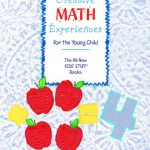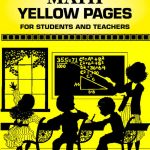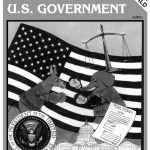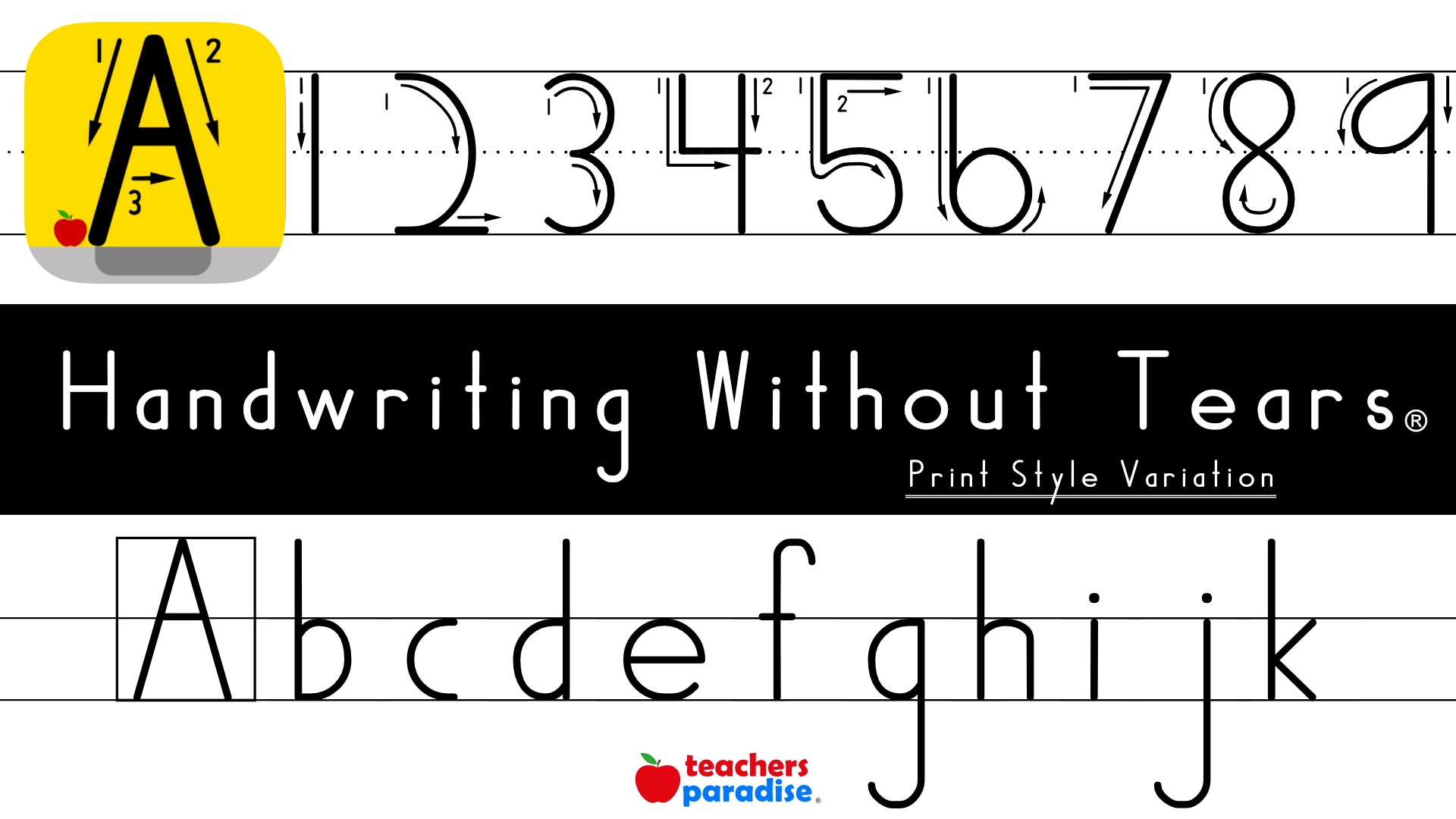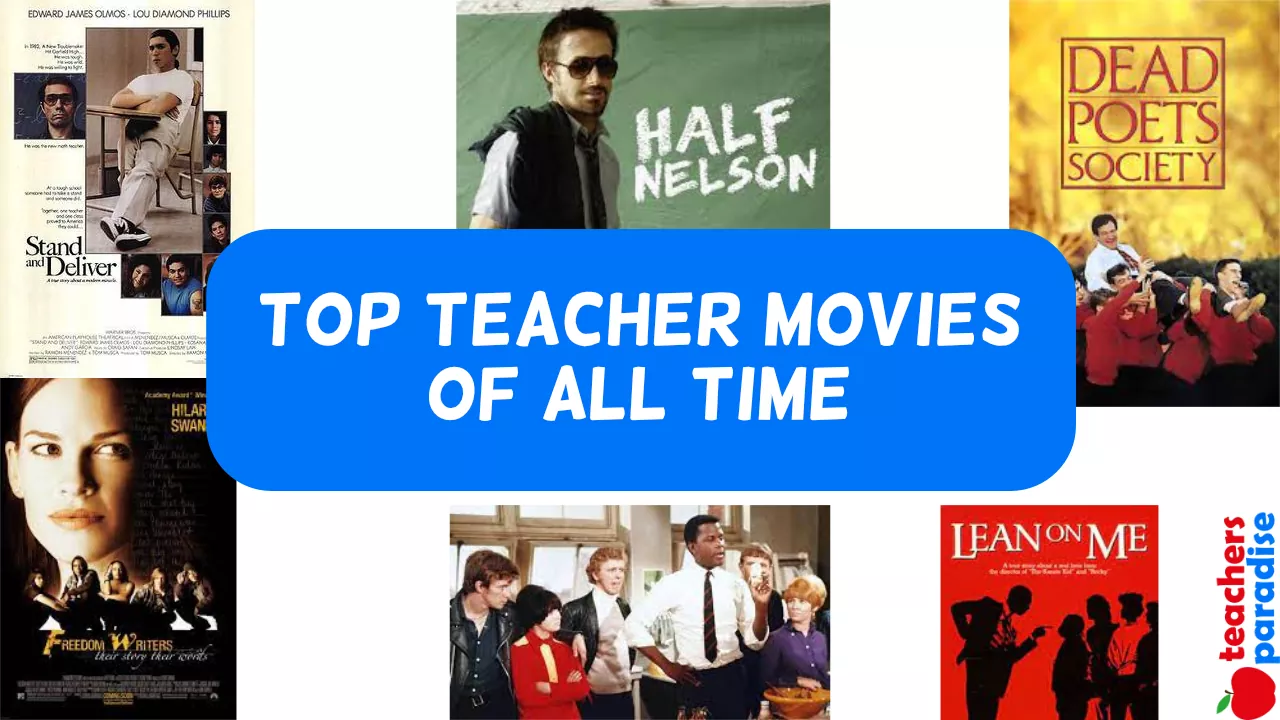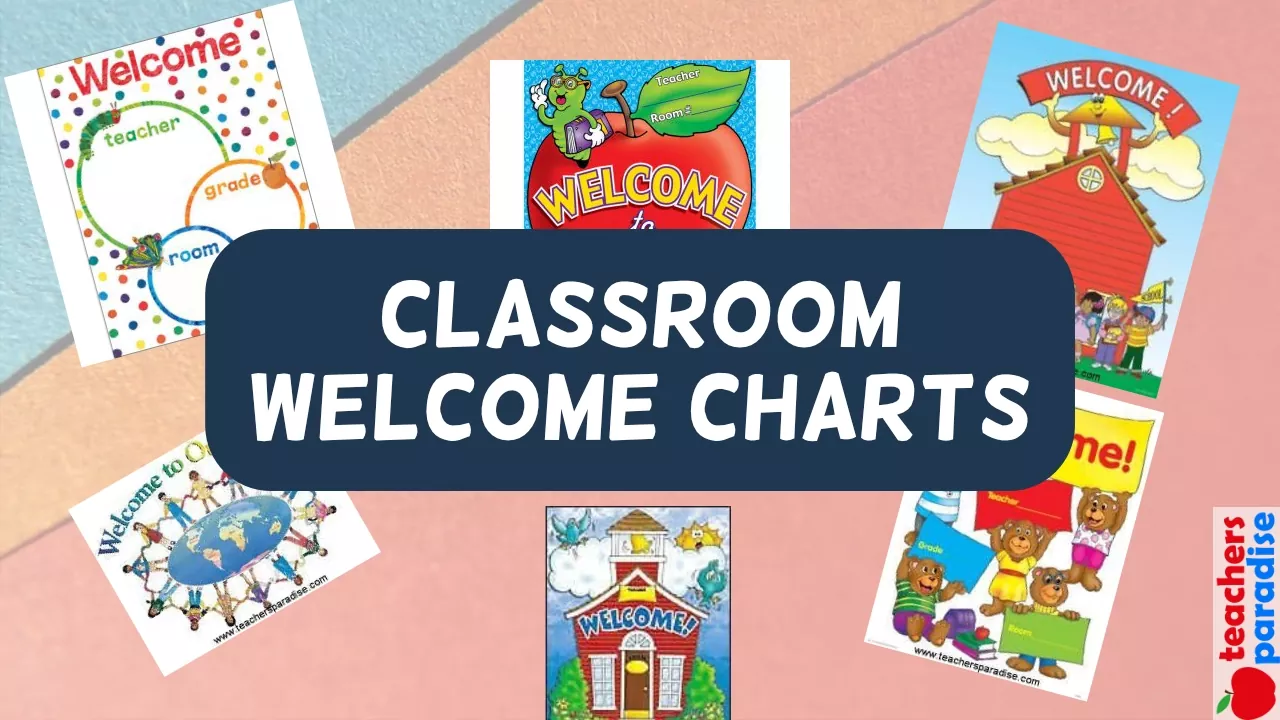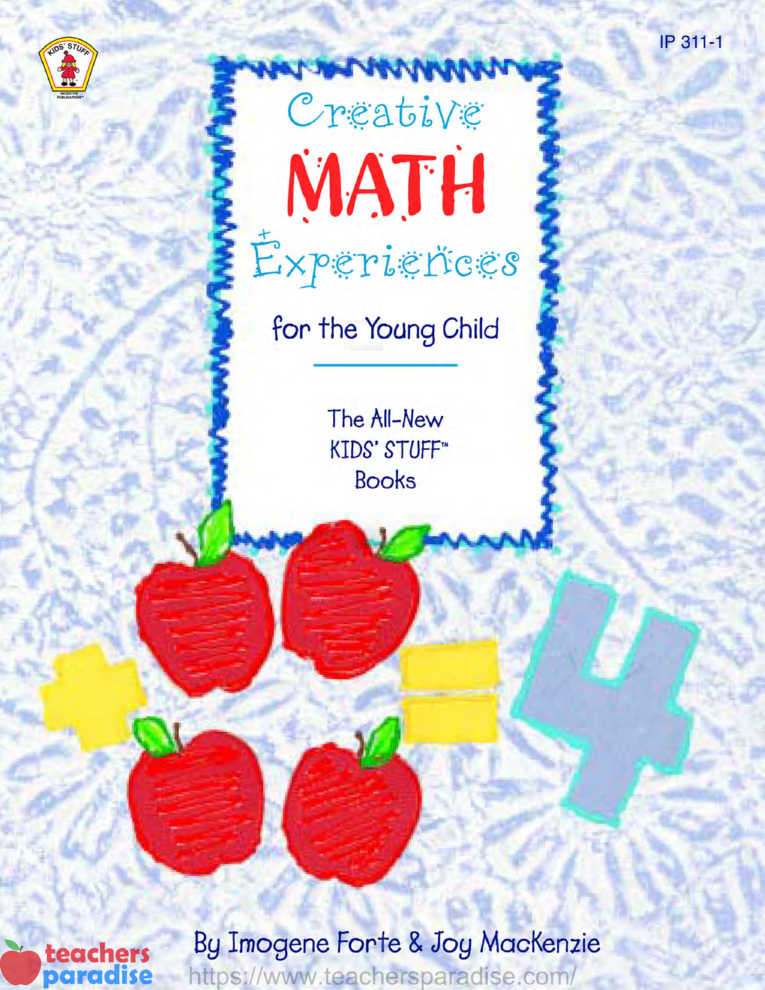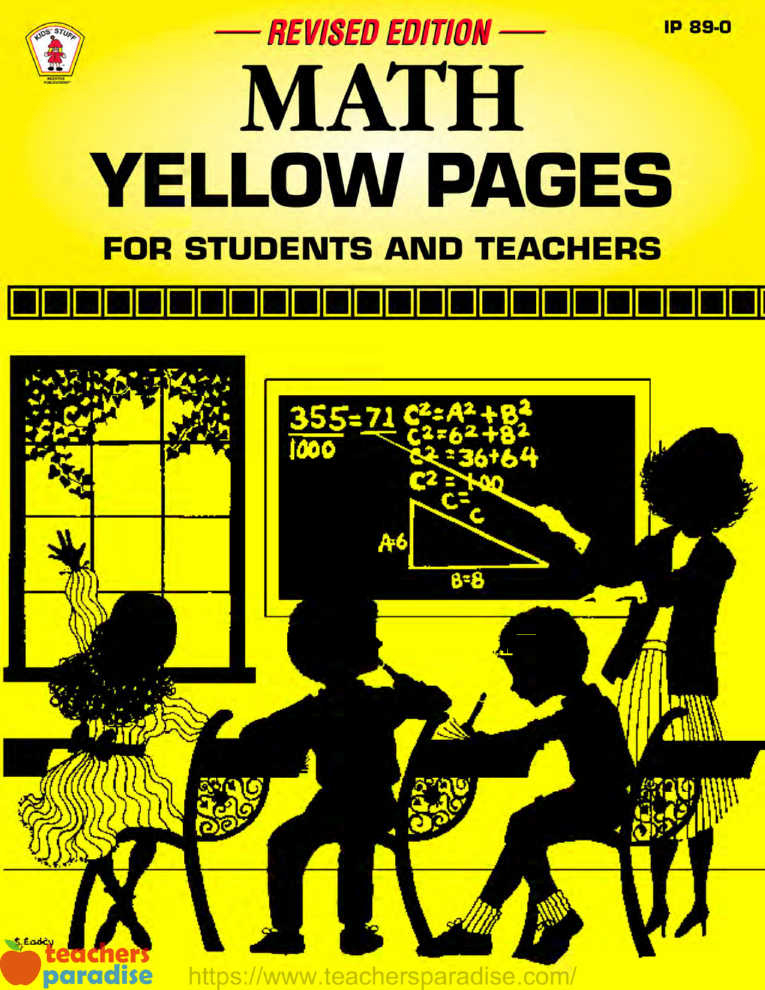Dozens of Quick and Easy Activities That Infuse Learning Into Every Minute of the Day
What is it that makes transition times special? Perhaps it’s that they provide a precious opportunity to take a few minutes to do something both meaningful and fun. Or maybe it’s the looser structure these times offer, just right for presenting an activity in a brief period of time. Sometimes the best part of any activity is the beginning or end. With transitions it’s all beginning and end—there’s no time for the middle!
Perhaps we love these mini-activities because they model the big and little real-life transitions we all make day to day. As adults we move from one activity to another several times a day, yet we hardly need to focus on how we do so. In the early childhood years, however, children need to learn how to make these changes and transitions. They need to learn how to shift focus, to pay attention, and to change activities (and moods!) quickly and easily. Our work with transitions in school helps prepare young children for the changes of life.
WORKSHEET & Sample PDF Activity
Sample PDF Activity
Of course, this kind of focus and ease with change is not easy to teach. Some of us may actually dread transitions because children can lose control and focus. I remember as a new teacher having moments when I thought I would never regain the children’s attention. That’s when I discovered that singing a song, or doing a finger play or a dramatic movement, out of the blue could instantly get them looking at me. Then if I engaged them with the activity, too, we were all focused and ready to go on with whatever I had planned.
Most of the activities in this book involve one or more of the arts, such as dance, music, drama, and visual arts. In addition to using the activities as transitions, you can also expand them into longer lessons. The possibilities are endless. Sing a song, do a dance, be dramatic and playful knowing that the learning will happen when children are relaxed, comfortable, and engaged!

It’s All About Literacy!
While traditionally we think of language, reading, and writing as “literacy,” there are many forms of literacy that young children develop in the early years. In recent years, studies have supported the expansion of the definition of the word literacy to a more overarching term for competence across a variety of skills. The transition activities in each section of this book (language arts, math, and seasonal) are designed to support children’s literacy development not only with language, reading, and writing, but also with math, social, physical, and creative skills. The goal in using these activities is to meet the needs of the whole child, encourage children’s multiple strengths and intelligences, and provide reinforcement for all of their budding literacy skills.
How to Choose and Use Transition Activities
Activities for transition times come in all shapes and sizes, just like kids! Transitions can be a short interlude or the beginning of something new and bigger. They can be the movement from one event to another. Transitions can provide an opportunity to calm and center children or to use up extra energy in a positive way.

The transition activities in this book are organized into three main sections: Language Arts Transitions (pages 11–60), Math Transitions (pages 61–111), and Month-by-Month Transitions (pages 112–160). You’ll find that activities in each of these sections generally fit into one of the following categories:
• Movement from place to place, such as Alphabet Countdown! (page 14)
• Waiting activities, such as The Case of the Missing Pattern (page 89)
• Action breaks, such as Jack, Jump! (page 56)
• Attention grabbers, such as Look at This! (page 129)
• Settling-down activities, such as Cats and Dogs (page 136)
• Thought-provoking times, such as Thinking Caps (page 40)
• Language builders, such as Name Game (page 32)
• Teachable moments, such as Quickly, Quietly (page 52)
Many activities naturally combine more than one type of transition—for example, Story Chains (page 34) builds language skills as children move from one place to the next. When choosing activities, consider the type of transition you need at any given time as well as the focus. For example, with Give Me Three! (page 69), children move from one place to another while reinforcing number recognition. A Valentine’s Transition Game (page 137) will get them there while they celebrate a special time of the year! For ease of use, activities follow a basic format:
Skills and Concepts: This list highlights key skills supported by each activity.
What to Do: Use these step-by-step directions to guide children in learning-filled transition times—from getting their attention at the start to focusing them on what comes next.
Variations: Put a fresh twist on transition activities with these suggestions. Changing something about an activity while maintaining the general procedure builds children’s confidence in their abilities while encouraging them to try new things.
Teaching Tip
When possible, model transitions to make it easier for children to successfully follow along themselves.
Keep in mind that in addition to the skills identified in Skills and Concepts, activities naturally incorporate other skills. For example, I’m Thinking of a Letter (page 12) reinforces, as identified in the Skills and Concepts list, alphabet recognition, listening, and following directions. As children play, they are also using listening skills, strengthening receptive and expressive language, taking turns, and cooperating with one another. You can also apply skills of your choice to the format of a particular transition. For example, if you are working with students on writing letters, you can incorporate that skill in the transition activity Sound It Out . . . On Your Way Out! (page 30) by inviting children to write their letters on mural paper and create a cooperative art project with them.
Resources
- 50 Fun and Easy Brain-Based Activities for Young Learners by Ellen Booth Church (Scholastic, 2002): Engaging activities correlate with current brain-based research to support young children in learning.
- The Learning Power of Laughter: Over 300 Playful Games and Activities That Promote Learning With Young Children by Jackie Silberg (Gryphon House, 2004): This practical resource is filled with finger plays, jokes, poems, and more, which are easily adapted for use during transition times.
- Phonics From A to Z: A Practical Guide (2nd ed.) by Wiley Blevins (Scholastic, 2006): This comprehensive resource offers practical strategies and lessons for phonics instruction, many of which can be adapted for use as transition activities.
- Start Smart by Pam Schiller (Gryphon House, 1999): Playful activities—many just right for transition times—are designed to boost brain development in young children and are accompanied by explanations of how and why they work.
- Transition Time: Let’s Do Something Different by Jean Feldman (Gryphon House, 1995): Songs, finger plays, games, and stories are organized by typical parts of a school day, such as circle time, clean-up, line-up, and lunch, making it easy to turn transitions from one part of the day to the next into teachable moments.
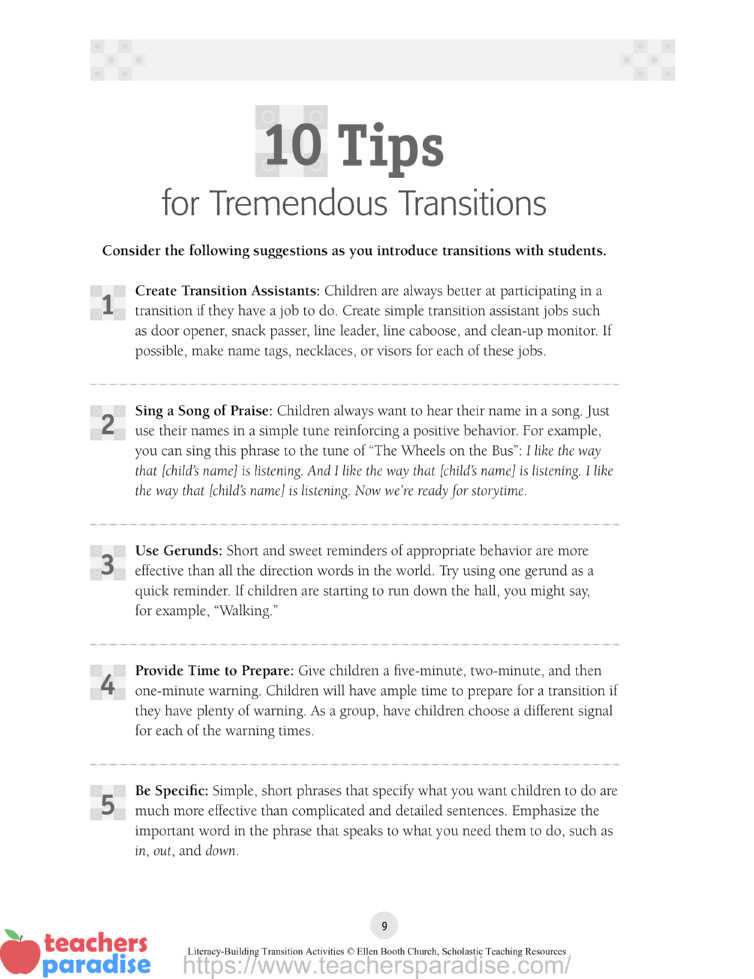
10 Tips for Tremendous Transitions
Consider the following suggestions as you introduce transitions with students.
- Create Transition Assistants: Children are always better at participating in a transition if they have a job to do. Create simple transition assistant jobs such as door opener, snack passer, line leader, line caboose, and clean-up monitor. If possible, make name tags, necklaces, or visors for each of these jobs.
- Sing a Song of Praise: Children always want to hear their name in a song. Just use their names in a simple tune reinforcing a positive behavior. For example, you can sing this phrase to the tune of “The Wheels on the Bus”: I like the way that [child’s name] is listening. And I like the way that [child’s name] is listening. I like the way that [child’s name] is listening. Now we’re ready for storytime.
- Use Gerunds: Short and sweet reminders of appropriate behavior are more effective than all the direction words in the world. Try using one gerund as a quick reminder. If children are starting to run down the hall, you might say, for example, “Walking.”
- Provide Time to Prepare: Give children a five-minute, two-minute, and then one-minute warning. Children will have ample time to prepare for a transition if they have plenty of warning. As a group, have children choose a different signal for each of the warning times.
- Be Specific: Simple, short phrases that specify what you want children to do are much more effective than complicated and detailed sentences. Emphasize the important word in the phrase that speaks to what you need them to do, such as in, out, and down.
- Be Surprising: Just about the time children are getting used to a particular way you are making transitions, change it! Brain research tells us that novelty or change in a particular pattern or sequence will increase children’s attention span and engage their thinking.
- Model Transitions: Often, early childhood programs have more than one adult in the classroom. It is extremely helpful if one adult is the transition leader or caller and the other adult acts as a model for the children. This adult can model listening for directions or following directions while encouraging children to join in. Modeled behavior is more powerful and instructive than spoken directions.
- Record Music: Invite children to help you choose music to be used as specific transition reminders or cues. They may like to record an energetic sound for clean-up, some quiet mood music for rest time, and a marching sound for circle time. Change the music frequently to keep interest (and cooperation) high!
- Create a “Works-in-Progress” Area: Children often don’t want to transition because they’re not finished with something they’re doing. Create a shelf area where children can safely place a project that is not complete. Then make time for children to go back to the project at another time. Provide name tags for children to place on their work-in-progress.
- Personalize Assistance: There are always some children who have a difficult time shifting focus. For these children it is best to individually prepare them. Whisper to them that it is almost time to clean up or to move on to the next activity. Ask them to help you get the others ready for the transition or give them a job to do—such as giving the transition or freeze signal. The key is to make children feel involved with the transition!
Transitions and the Brain
Interestingly, brain research supports
the use of transitions as a teaching tool. Studies have shown that the brain pays the most attention to (and remembers best) the first and last thing presented in a lesson. The material in the middle just doesn’t engage the mind (and is not remembered) as completely as what’s happening on either side of it! When you are using transition time to teach, you are supporting children’s natural brain development.
Language Arts Transitions
Transition time is also language and literacy time! It is the perfect time to introduce, explore, and practice the literacy skills you teach throughout the day. In fact, these literacy mini-lessons can be an essential part of your literacy program. They provide children with the opportunity to apply the skills they’re learning in the classroom to “real life” experiences—thus demonstrating to children how literacy skills are something they use not only in school but everywhere!
You can use literacy transitions to quiet the group and gain children’s attention, move them from place to place, provide a creative break in the action, or constructively fill waiting time. In addition to providing needed structure for transitions, the activities in this section reinforce skills, develop new ones, and build memory and retention. (See pages 7–8 for a comprehensive list of skills.)
As you choose transition activities to use with children, keep in mind the importance of repetition. The more you use a particular transition, the more children gain understanding. So have fun exploring a transition for a while and then switch to another. But remember to revisit the transitions throughout the year as a way of assessing children’s understanding, expanding their thinking, and building their confidence as learners!
Language Arts Transitions: Alphabet Recognition
I’m Thinking of a Letter Activity

Play an alphabet game that transitions children two by two to the next activity.
What to Do
- Ask a letter question using this example as a model: “Banana, ball, billboard, beach . . . what letter am I thinking of?”
- Children raise hands and the child who answers correctly invites a partner to say one more word that starts with the same letter.
- Together, these children move to the next activity. Continue transitioning children in this way by twos to the next activity.
Variations
Add an Alphabet Chart: Add an alphabet chart for added work with visual discrimination of letters. When you ask the question “What letter am I thinking of?” children have to identify the letter on the chart and name it.
Reverse It! Say the letter and give the description of something that starts with the sound. Ask children to guess what it is. The child who guesses correctly invites a partner to name another object whose name begins with the same letter.
Conduct the Alphabet! Activity
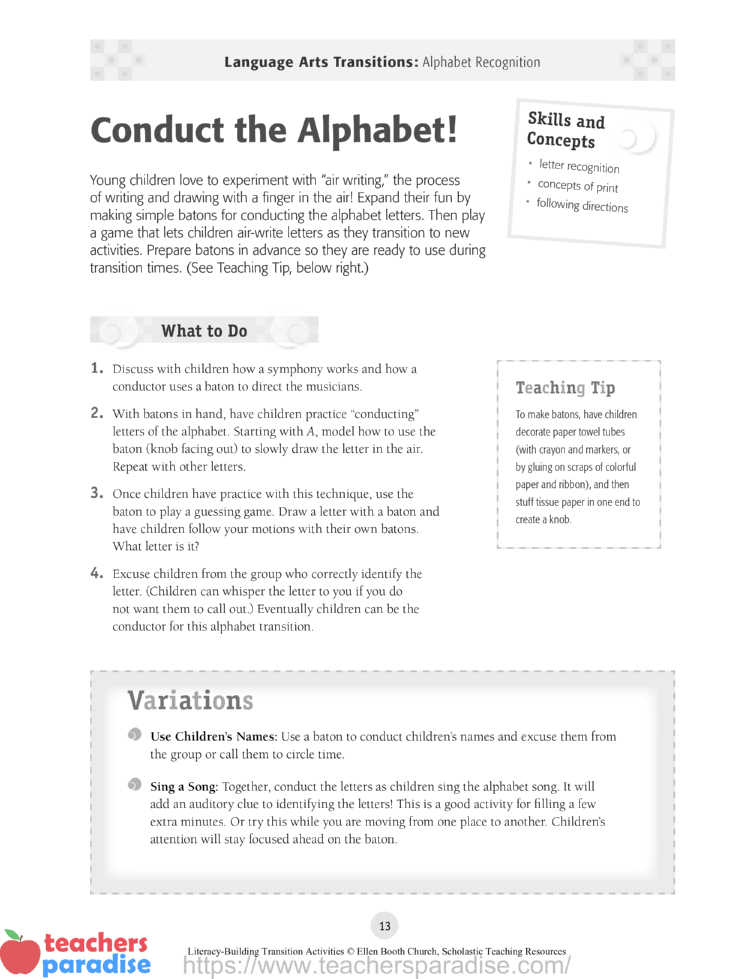
Young children love to experiment with “air writing,” the process of writing and drawing with a finger in the air! Expand their fun by making simple batons for conducting the alphabet letters. Then play a game that lets children air-write letters as they transition to new activities. Prepare batons in advance so they are ready to use during transition times. (See Teaching Tip, below right.)
What to Do
- Discuss with children how a symphony works and how a conductor uses a baton to direct the musicians.
- With batons in hand, have children practice “conducting” letters of the alphabet. Starting with A, model how to use the baton (knob facing out) to slowly draw the letter in the air. Repeat with other letters.
- Once children have practice with this technique, use the baton to play a guessing game. Draw a letter with a baton and have children follow your motions with their own batons. What letter is it?
- Excuse children from the group who correctly identify the letter. (Children can whisper the letter to you if you do not want them to call out.) Eventually children can be the conductor for this alphabet transition.
Variations
Use Children’s Names: Use a baton to conduct children’s names and excuse them from the group or call them to circle time.
Sing a Song: Together, conduct the letters as children sing the alphabet song. It will add an auditory clue to identifying the letters! This is a good activity for filling a few extra minutes. Or try this while you are moving from one place to another. Children’s attention will stay focused ahead on the baton.
Alphabet Countdown! Activity
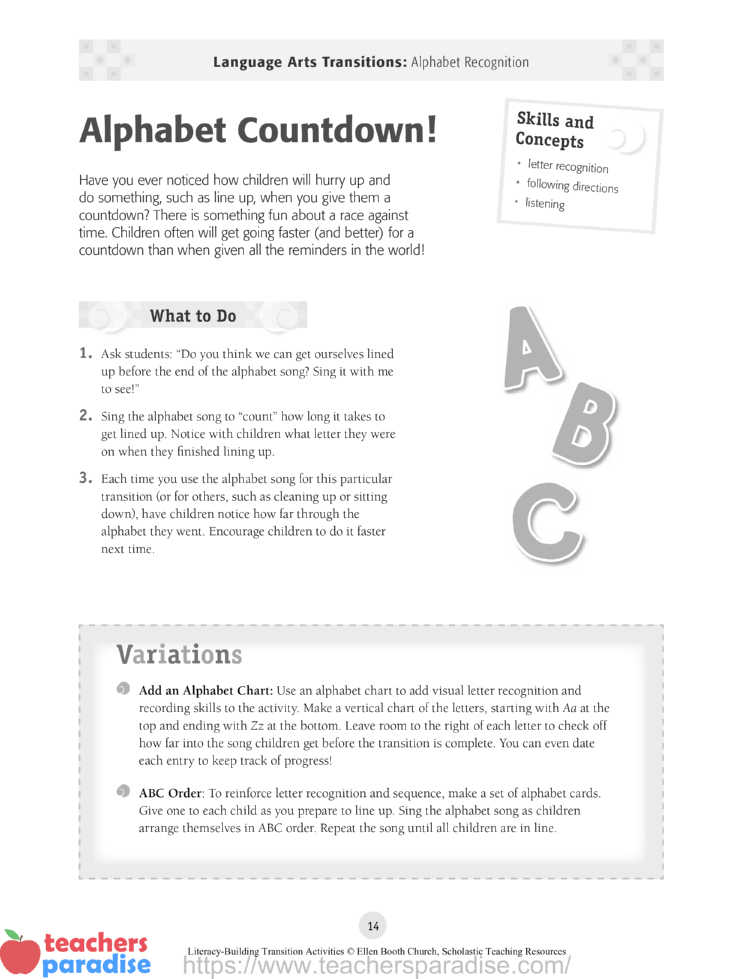
Have you ever noticed how children will hurry up and do something, such as line up, when you give them a countdown? There is something fun about a race against time. Children often will get going faster (and better) for a countdown than when given all the reminders in the world!
What to Do
- Ask students: “Do you think we can get ourselves lined up before the end of the alphabet song? Sing it with me to see!”
- Sing the alphabet song to “count” how long it takes to get lined up. Notice with children what letter they were on when they finished lining up.
- Each time you use the alphabet song for this particular transition (or for others, such as cleaning up or sitting down), have children notice how far through the alphabet they went. Encourage children to do it faster next time.
Variations
Add an Alphabet Chart: Use an alphabet chart to add visual letter recognition and recording skills to the activity. Make a vertical chart of the letters, starting with Aa at the top and ending with Zz at the bottom. Leave room to the right of each letter to check off how far into the song children get before the transition is complete. You can even date each entry to keep track of progress!
ABC Order: To reinforce letter recognition and sequence, make a set of alphabet cards. Give one to each child as you prepare to line up. Sing the alphabet song as children arrange themselves in ABC order. Repeat the song until all children are in line.
Stick It to Me Activity

A sticky note in the hand signals young children to leave circle time and focuses their attention as they transition to their next activity.
What to Do
- Write letters on sticky notes (one letter per note). As children leave circle time, place a sticky note in the palm of each one’s hand.
- When children receive their sticky notes, they look around the classroom to find an object whose name begins with their letter’s sound.
- When children think they have found a match, they place the sticky note on the object. Check to see if a correct match has been made. (You may wish to write children’s names on one side of the sticky note to assist with assessment.)
Variations
Sticky Note Match: Hide a second set of sticky notes (with letters on them) around the classroom and have children match the sticky notes they have on their palms to the hidden ones. They can match lowercase to lowercase, uppercase to uppercase, or, if appropriate, lowercase to uppercase.
Letter Box: Instead of sticky notes, use alphabet cards, letter tiles, or magnetic letters. Place them in a box and let children choose their letter at random.
Table of Contents
Introduction – 4
How to Choose and Use Transition Activities – 5
Resources – 6
Skills Overview – 7
10 Tips for Tremendous Transitions – 9
Language Arts Transitions – 11
Alphabet Recognition – 12
Phonemic Awareness – 19
Storytelling – 33
Word Play – 40
Vocabulary – 47
Poetry – 54
Math Transitions – 61
Counting and Estimating – 62
Sorting and Classifying – 73
Sequencing, Patterning, and Seriating – 81
Adding and Subtracting – 91
Measuring – 100
Graphing – 106
Month-by-Month Transitions – 112
September – 113
October – 118
November – 123
December – 128
January – 132
February – 136
March – 141
April – 146
May – 151
June – 156
ISBN-13: 978-0-439-65088-5
ISBN-10: 0-439-65088-7




